搜索


Recently, Wu Jianbo, Gao Wenbai, and Yao Zhenpeng from the Atomic Manufacturing Centre at the Future Materials Innovation Centre, Zhangjiang Advanced Research Institute, Shanghai Jiao Tong University, achieved breakthrough progress in regulating surface ordering behaviour of platinum-based multi-component core-shell systems at the atomic level. Their research findings, titled ‘The role of surface substitution in the atomic disorder-to-order phase transition in multi-component core-shell structures’ (DOI: 10.1038/s41467-024-54104-5) was published in the premier international materials science journal Nature Communications, with Shanghai Jiao Tong University listed as the first author institution. The research team employed advanced in situ characterisation techniques to track the structural evolution of the Pd@Pt-Co model catalyst during low-temperature heat treatment. This was further combined with in situ, atom-level compositional characterisation to establish the relationship between composition and structure. Concurrently, based on classical metallurgical theory and DFT calculations, the diffusion behaviour of atoms within the multi-component core-shell system was elucidated. The study revealed that during heat treatment, Pd diffusion within the Pd@Pt-Co core-shell particles replaces part of the initial Pt in the Pt-Co shell. This forms a ternary (Pt, Pd)-Co system with a lower phase transition temperature at the surface, enabling surface ordering transformation under low-temperature conditions. Consequently, the design and preparation of intermetallic compounds with controllable crystal planes were achieved. The paper's first author is Dr. Zhang Wencong from the School of Materials Science and Engineering at Shanghai Jiao Tong University. Wu Jianbo, Gao Wenbai, and Yao Zhenpeng from the School of Materials Science and Engineering, Shanghai Jiao Tong University; the Centre for Hydrogen Science; and the State Key Laboratory of Metal Matrix Composites served as co-corresponding authors. The research received substantial support from Professor Deng Tao and Associate Researcher Shang Wen from the School of Materials Science and Engineering, Shanghai Jiao Tong University, as well as Dr Wu Dongchang from Thermo Fisher Scientific. Shanghai Jiao Tong University is listed as the first completing institution.
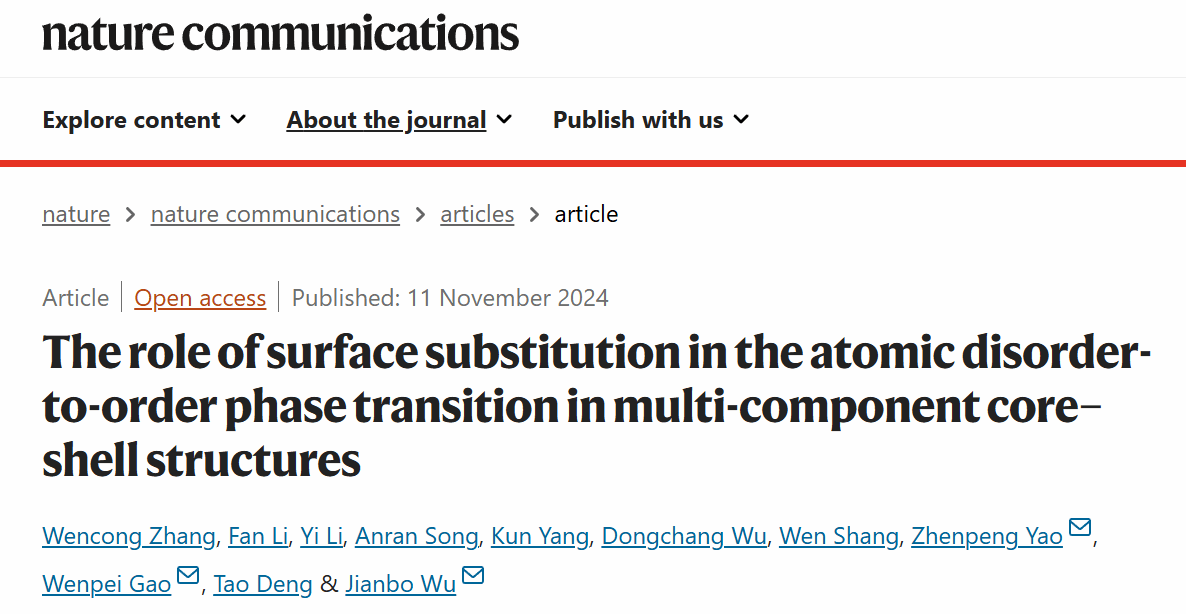
Intermetallic compounds with controllable crystal planes exhibit outstanding activity and stability in catalytic reactions. However, under conventional high-temperature heat treatment regimes, the coexistence of multiple atomic diffusion behaviours within the alloy system often necessitates sacrificing highly active crystal planes for ordered transformations. Consequently, understanding the atomic dynamics governing the material's disorder-to-order transition is crucial for guiding the controlled preparation of intermetallic compounds with specific crystal planes, particularly in multicomponent systems. Here, utilising Pd@Pt-Co cubic nanoparticles as a research platform, we employ in situ micro-characterisation techniques and atomic-level compositional analysis to meticulously observe and analyse the atomic diffusion behaviours involved in the low-temperature heat treatment of this model catalyst, particularly those related to the ordering transition. Our findings reveal that Pd diffuses outward within the Pd@Pt-Co particles, partially substituting Pt and forming a ternary (Pt, Pd)-Co system at the surface. Subsequently, the surface undergoes an ordering transition at 400 °C. At higher temperatures, excessive interdiffusion of atoms within the particles alters the stoichiometric ratio, diminishing the ordered characteristics and leading to pronounced morphological changes alongside the disappearance of the original core-shell interface. Furthermore, DFT calculations indicate that the (Pt, Pd)-Co ternary system exhibits lower phase transition temperatures and atomic diffusion activation energies compared to Pt-Co alloys. This understanding of atomic behaviour is crucial for the design and preparation of intermetallic compounds with controllable crystal planes within complex systems.
Researchers employed a wet chemical method to synthesise Pd@Pt-Co cubic particles with uniform size and morphology as model catalysts for heat treatment. HAADF-STEM imaging and atomic-level compositional characterisation confirmed the uniform deposition of a Pt-Co shell layer on the Pd seed surface.

Figure 1. Structural and compositional characterisation of initial Pd@Pt-Co core-shell cubic particles. a, Low-magnification HAADF-STEM image. b, AC-STEM image of a single Pd@Pt-Co particle. c, Localised enlargement of a single Pd@Pt-Co particle. d–f, Atomic-level compositional maps of localised enlargement regions, showing Pt (d), Co (e), and Pd (f). g, Line scan compositional map corresponding to the white dashed-line box region in Figure c.
To investigate atomic diffusion behaviour during low-temperature heat treatment of the Pd@Pt-Co catalyst, researchers employed in situ electron microscopy to observe structural evolution, including ordering transitions and surface/interface changes during both isothermal holding and heating phases. Findings reveal that the surface of Pd@Pt-Co core-shell particles
undergo an ordering transition as early as 400 °C. During the heating process, pronounced growth of ordered structures, loss of surface morphology, and disappearance of interfaces were observed, all reflecting active atomic diffusion within the particles. Notably, researchers obtained distribution information of the ordered structures by extracting diffraction spots from the corresponding FFT images of particles at different temperatures and performing inverse Fourier transforms (IFFT).
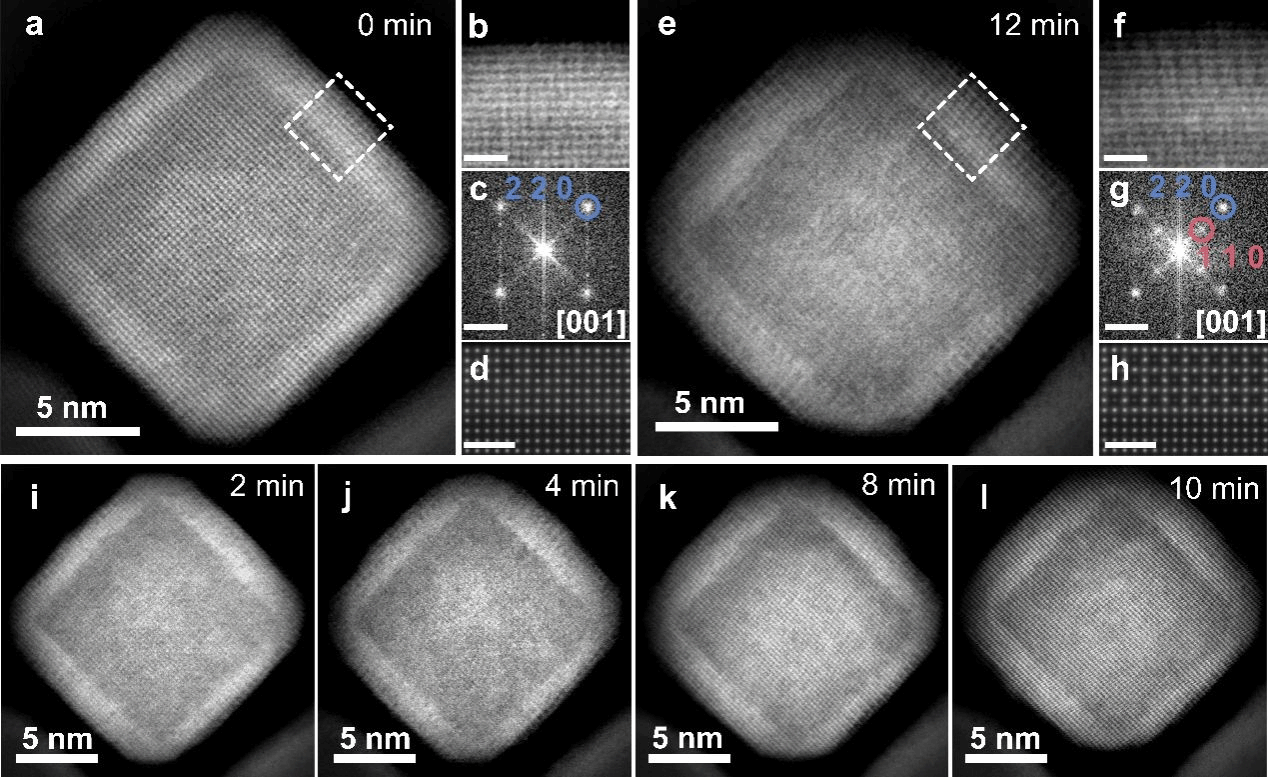
Figure 2. Sequence of HAADF-STEM images of Pd@Pt-Co particles during heat treatment at 400 °C. a–h: HAADF-STEM images at 0 and 12 minutes of heat treatment at 400 °C (a, e); enlarged HAADF-STEM images of regions selected by white dashed boxes (b, f); corresponding FFT images (c, g); and simulated STEM images (d, h). i–l, HAADF-STEM images corresponding to 2, 4, 8, and 10 minutes of heat treatment at 400 °C.
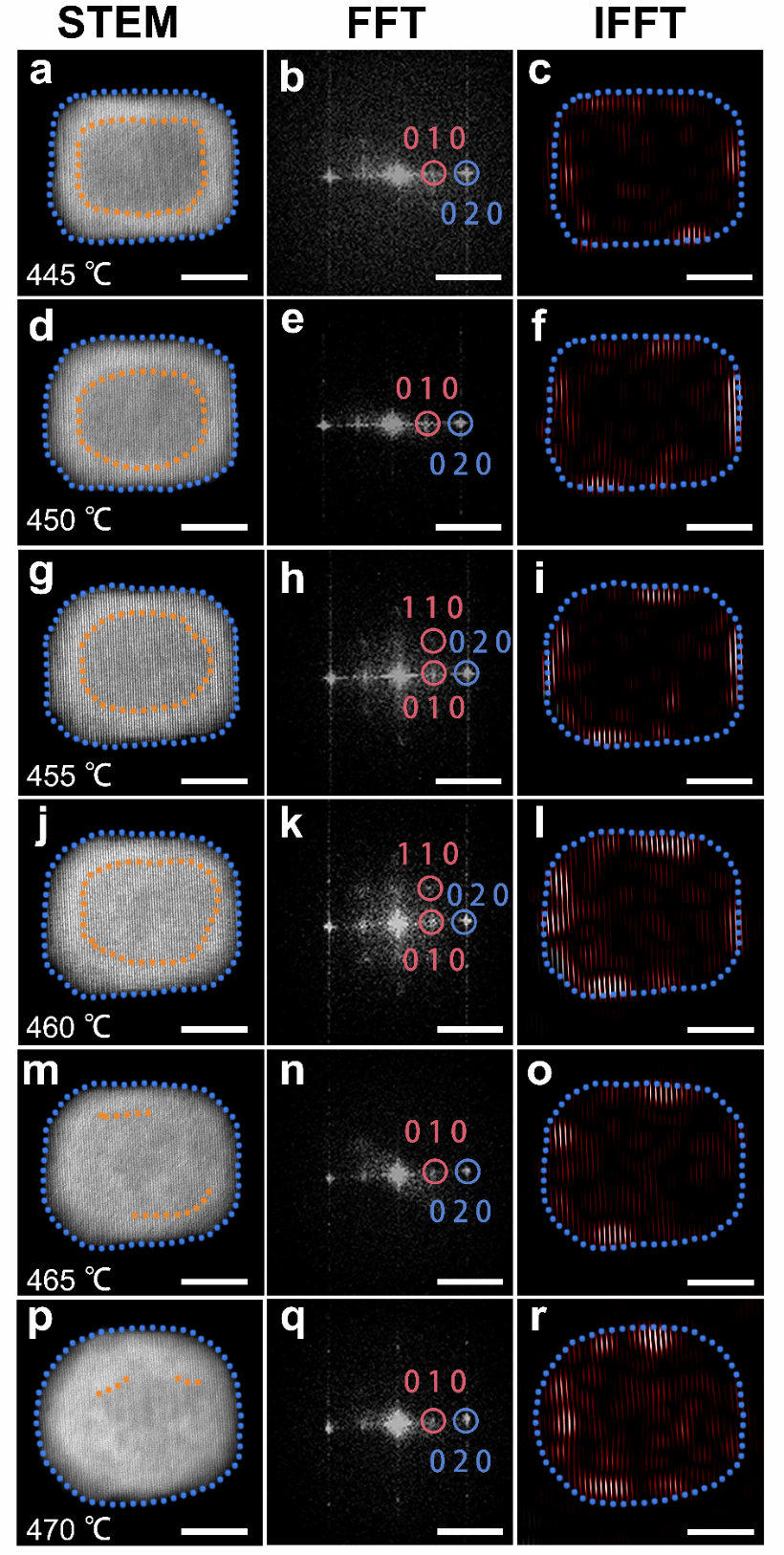
Figure 3. Sequence of HAADF-STEM images, corresponding FFT and IFFT plots of Pd@Pt-Co particles during heating treatment.
Given the composition dependence of ordered structures, atomic-level compositional characterisation was performed on particles obtained in situ. The findings revealed that the ordered structure corresponds to a ternary (Pt, Pd)-Co system rather than the initial Pt-Co system in the shell layer. Based on the compositional distribution and structural similarity between Pt and Pd, it is proposed that Pd diffused outward, replacing Pt in the surface region, thereby transforming the shell layer from a Pt-Co system to a ternary (Pt, Pd)-Co system.
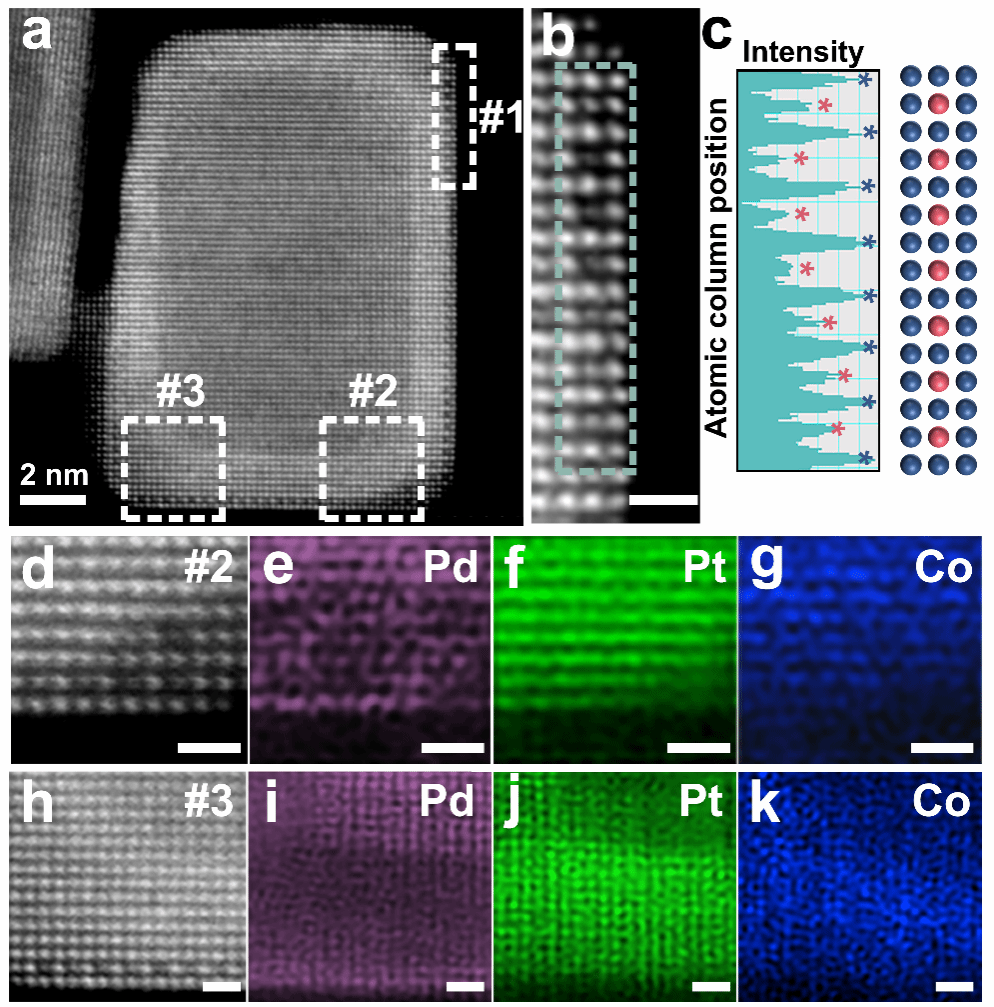
Figure 4. Structural and compositional characterisation of Pd@Pt-Co particles obtained via in situ external heat treatment.
To further elucidate the influence of composition on the ordering transition, the researchers employed DFT calculations to compare the critical phase transition temperatures (Tc) of the Pt-Co binary system and the (Pt, Pd)-Co ternary system. The calculations revealed that the Tc of the (Pt, Pd)-Co ternary system decreased by 362 °C relative to the Pt-Co binary system. Furthermore, drawing upon classical metallurgical theory, the researchers introduced temperature concepts such as the Taman temperature (TT) and the Hüttig temperature (TH) to describe atomic diffusion behaviour within distinct regions of the particles. Integrating phase transition thermodynamics, they provided a qualitative description of atomic diffusion behaviour during the low-temperature heat treatment of Pd@Pt-Co particles.
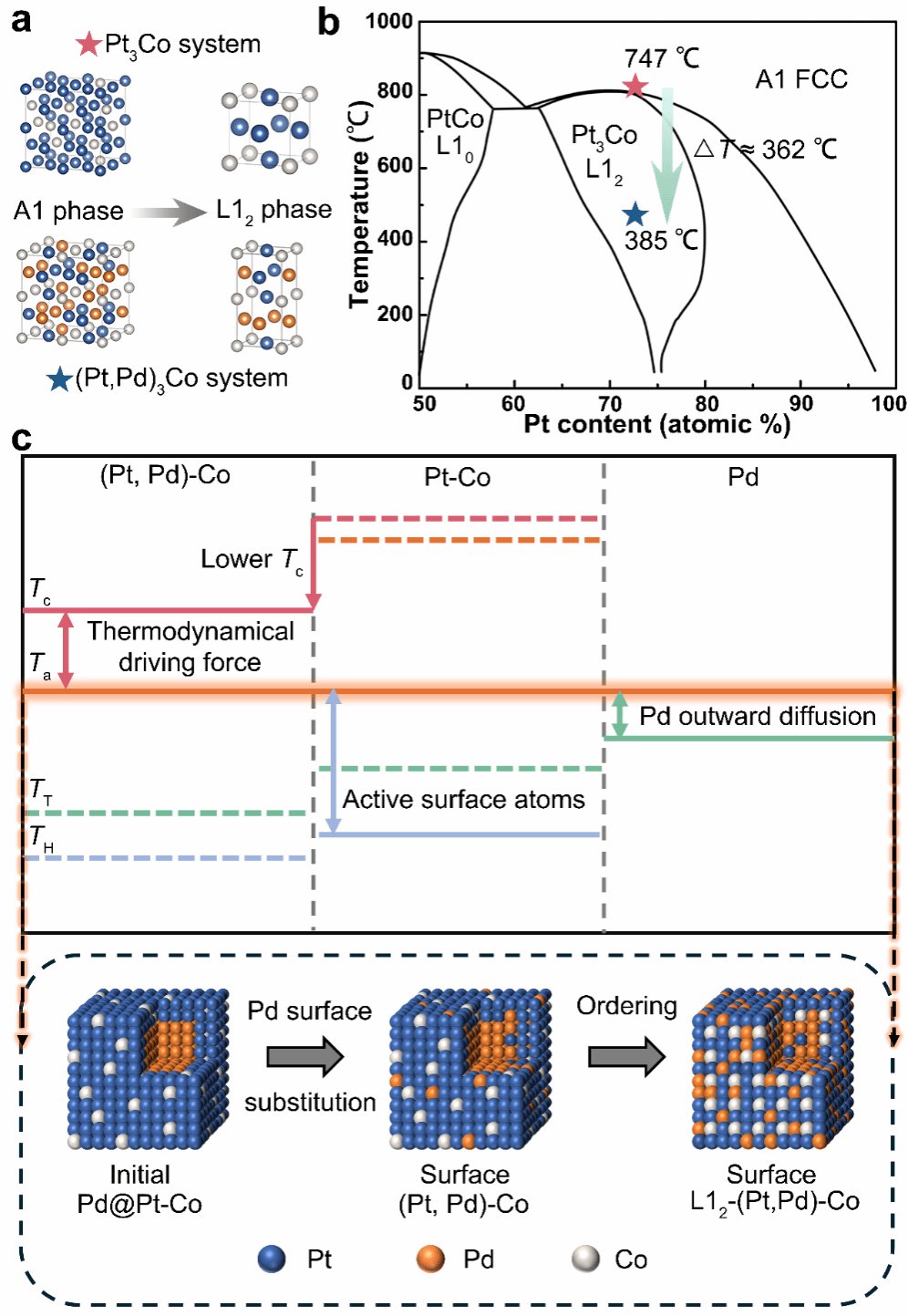
Figure 5. Mechanistic explanation of low-temperature phase transitions in Pd@Pt-Co particles. a, Unit cell models corresponding to the Pt-Co binary system and the (Pt, Pd)-Co ternary system. b, Comparison of phase transition temperatures for both systems obtained via DFT calculations. c, Schematic illustrating the temperature concept based on composition, alongside a model diagram depicting the structural evolution of Pd@Pt-Co particles at a given heat treatment temperature.
This work investigates structural evolution behaviour in multinary systems at the atomic scale, providing potential strategies for achieving controlled crystallographic ordering transformations in complex systems.
This research received funding from the National Key R&D Programme, the National Natural Science Foundation of China, the Shanghai Outstanding Academic/Technical Leader Programme, the Shanghai Municipal Education Commission Innovation Project, and the Hydrogen Science Centre, Joint Research Centre for Materials Genome, and Joint Research Centre for Clean Energy at Shanghai Jiao Tong University.
Full paper link: https://www.nature.com/articles/s41467-024-54104-5






 Address:No.1308 Keyuan Road, Pudong District, Shanghai
Address:No.1308 Keyuan Road, Pudong District, Shanghai Phone:86-21-54740000
Phone:86-21-54740000 E-mail:zias@sjtu.edu.cn
E-mail:zias@sjtu.edu.cn